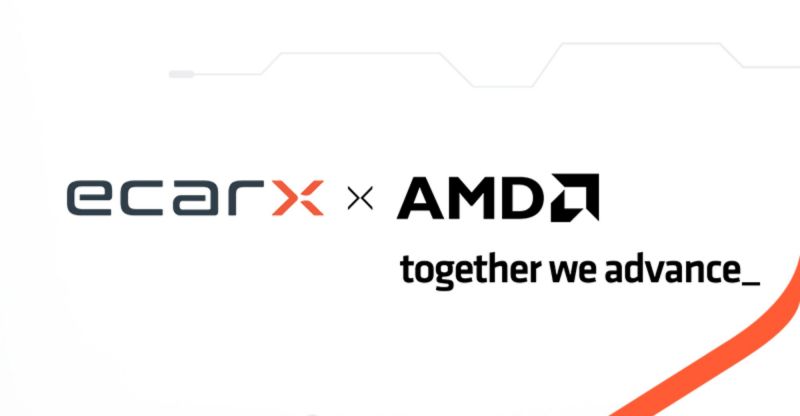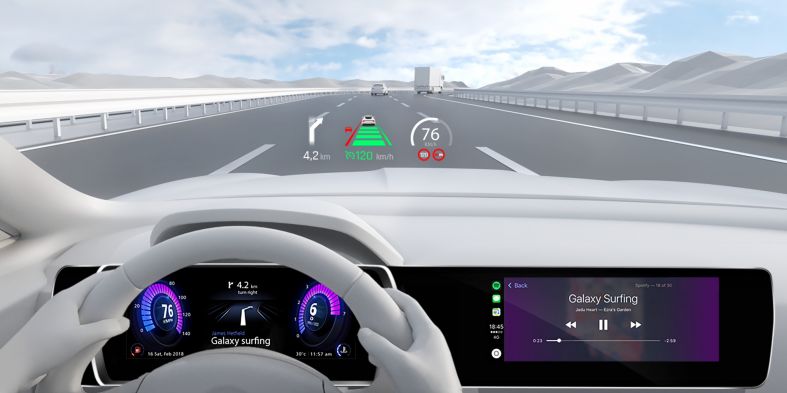Chipmaker AMD to Collaborate with ECARX on a Digital Cockpit, In-Vehicle Computing Platform for Next-Gen EVs
【Summary】Leading computing hardware and semiconductor developers continue to expand into the automotive space as modern vehicles are becoming more like connected smartphones. That latest partnership is from Silicon Valley-based chipmaker AMD and mobility tech startup ECARX. The two companies will work together on an in-vehicle computing platform for next-generation electric vehicles (EVs).

Leading computing hardware and semiconductor developers including Qualcomm Technologies Inc, NVIDIA, Intel Corp and Advanced Micro Devices, Inc (AMD), continue to expand into the automotive space as modern vehicles are becoming more like connected smartphones powered by software that can be updated over the air.
That latest partnership is from Silicon Valley-based chipmaker AMD and mobility tech startup ECARX, a company backed by automaker Zhejiang Geely Holding Group (Geely), which is the parent company of Volvo Cars.
AMD and ECARX will work together on an in-vehicle computing platform for next-generation electric vehicles (EVs), expected to be in mass production for global rollout in late 2023.
ECARX was founded in 2017 by two auto industry entrepreneurs, Chairman and CEO Ziyu Shen and Eric Li (Li Shufu), who is also the founder and chairman of Geely, one of the world's biggest automotive groups. In addition to being the parent company of Sweden's Volvo Cars, Geely holds ownership interest in Lotus, Lynk & Co and electric brand Polestar.
ECARX develops technologies related to chips, smart cockpit, intelligent driving, high-definition maps, big data and the internet of vehicles. The company's core products include infotainment head units (IHU), digital cockpits, vehicle chip-set solutions, a core operating system and integrated software stack. ECARX is also developing a full-stack automotive computing platform.
The ECARX automotive digital cockpit will be the first in-vehicle platform to be offered with AMD's powerful Ryzen Embedded V2000 processors and AMD Radeon RX 6000 Series GPUs paired with hardware and software developed by ECARX.
Over the past three years, ECARX's technology has been integrated into more than 3.2 million vehicles worldwide, according to the company.
AMD's Ryzen Embedded V2000 Series processors are the second generation designed for automotive in-vehicle infotainment and instrument panel displays and miniPC systems. Each V2000 Series processor can power up to four independent displays simultaneously in 4K resolution. Each is equipped with up to eight CPU cores and seven GPU compute units.
According to AMD, a single AMD Ryzen Embedded V2000 Series processor provides up to 30% better CPU performance and up to 40% better graphics performance over the previous generation.
The AMD hardware will offer immersive visual graphics and 3D rendering capabilities. The AMD-powered ECARX digital cockpit will launch with a driver information mode, heads-up display (HUD), rear seat entertainment, multiple vehicle display screens, multi-zone voice recognition, high-end gaming and a full 3D graphical user experience. These types of immersive 3D automotive cockpits will be used in the next generation of software-based EVs that support OTA updates.
"As car companies seek to deliver immersive experiences and intelligent features for their next-generation electric vehicles, the AMD-powered ECARX digital cockpit will address these needs for the global automotive market," said Rajneesh Gaur, corporate vice president and general manager, Embedded Business, AMD. "We are excited to work with ECARX as our first strategic ecosystem partner in China for the digital cockpit using our Ryzen Embedded V2000 processors and Radeon RX 6000 Series GPUs."

For computer hardware and semiconductor manufacturers like AMD, NVIDIA and Intel, the evolving auto industry creates new business opportunities.
The adoption of EVs is now a key underlying factor for growth in the automotive semiconductor market, which is expected to grow at a CAGR of 31% over 2021 - 2026, according to Asif Anwar, executive director, PBCS and EVS at Strategy Analytics.
"The EV revolution is here, with next-generation EV platforms at the leading edge of domain- and zonal-based architecture driving adoption of the digital cockpit, ADAS and the connected vehicle," said Anwar.
AMD's rival NVIDIA is also making inroads into the auto industry with a major collaboration with Mercedes-Benz. In June 2020, Mercedes-Benz announced a partnership with NVIDIA that will give future customers owners the ability to add new software to their vehicles, keeping them always up to date with new features. The updates will include software that supports higher levels of automated driving.
Mercedes Benz is developing an entirely new software-based architecture that supports over-the-air updates for its next generation vehicle fleet using NVIDIA's AI-powered DRIVE platform. The advanced software-based vehicle architecture will be introduced beginning with 2024 model year vehicles, eventually rolling out to the entire Mercedes Benz fleet globally.
By working together, the two companies plan on developing one of the most sophisticated and advanced computing architectures ever deployed in the auto industry.
ECARX is also planning to launch an IPO later this year in the U.S. In May, the company announced its plans to go public through a proposed merger with San Francisco-based COVA Acquisition Corp. (COVA). The transaction is expected to close in the fourth quarter of this year. Upon completion of the business combination, shares of ECARX will trade on Nasdaq under the ticker symbol "ECX".
In February, AMD completed its previously announced acquisition of semiconductor company Xilinx Inc for $50 billion in an all-stock transaction. The acquisition of Xilinx by AMD will significantly expand the company's portfolio of computing, graphics and adaptive system-on-a-chip (SoC) products.
The acquisition increases AMD's total addressable market from $80 billion to $135 billion, which includes both the computing processing market and automotive space.
The deal to Acquire Xilinx was originally valued at $35 billion, but AMD's rising stock price pushed up the transaction price.
Former Xilinx CEO Victor Peng now serves as President of the Adaptive and Embedded Computing Group at AMD.
-


Ford is Testing a New Robotic Charging Station to Assist Drivers of EVs With Disabilities
-


Ford Raises the Prices of the F-150 Lightning Electric Pickup Due to Rising Raw Material Costs
-


The BMW 7-Series to Feature HD Live Maps From HERE Technologies for Hands-Free Highway Driving in North America at Speeds up to 80 MPH
-


AutoX to Use the 'Eyeonic Vision Sensor' from California-based SiLC Technologies for its Robotaxi Fleet in China
-


LG Develops ‘Invisible’ Speaker Sound Technology That Could Revolutionize In-Vehicle Audio
-


Researchers at South Korea’s Chung-Ang University Develop a ‘Meta-Reinforcement’ Machine Learning Algorithm for Traffic Lights to Improve Vehicle Throughput
-


Zeekr’s New 009 Electric Passenger Van is the World’s First EV to Feature CATL’s Advanced ‘Qilin’ Battery With a Range of 510 Miles
-


Redwood Materials is Building an Electric Vehicle Battery Recycling Facility in South Carolina
- Toyota to Collaborate with Redwood Materials to Build a Closed Loop, EV Battery Recycling Ecosystem in the U.S.
- Mazda Outlines Plans to Invest $10.6 Billion in Electric and Hybrid Vehicle Development Through 2030
- Reservations for the Electric Fisker Ocean SUV Reach 50,000, The Company Shares New Details About its Second EV Being Built by Foxconn
- Ford Motor Co is Recalling 2.9 Million Vehicle That Could ‘Roll Away’ After the Transmission is Shifted Into Park
- China Added 963,000 Electric Vehicle Charging Piles Since January in its Push to Lead the World in EV Sales
- Tesla Shutters its San Mateo, CA Office, Lays Off Roughly 200 Autopilot Staff Without Notice
- Ford Motor Co Selects its Plant in Spain to Build 'Breakthrough' EVs for the European Market on a Next-Gen Architecture
- Chipmaker AMD to Collaborate with ECARX on a Digital Cockpit, In-Vehicle Computing Platform for Next-Gen EVs
- Lucid Launches New Performance Brand ‘Sapphire’ with a 1,200 Horsepower, Tri-Motor Version of the Lucid Air Sedan
- Baidu CEO Believes That SAE Level-4 Autonomous Driving Systems Will the First to Enter Commercial Use After L2, Skipping Over L3











 About Us
About Us Contact Us
Contact Us Careers
Careers